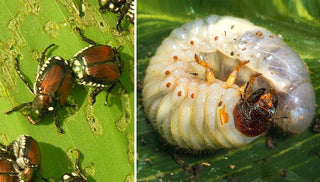What is the difference between Japanese Beetles and grubs?
Japanese beetles are a species of scarab beetles native to Japan and were first discovered in the U.S. in 1916. Though attractive with their metallic green and bronze colors they cause a lot of damage in the landscape and garden, devouring leaves and flowers of ornamental and edible plants.
Grubs are simply the immature ("teenager" stage) form of beetle — Japanese beetle larvae. Before maturing into beetles, grubs live under ground feeding on plant roots—especially lawn grass.
I have Japanese beetles on my plants! How do I get rid of them?
Japanese beetles can be controlled in several ways. You can either hand-pick them from affected plants and dispose of them, use insecticides, or set out pheromone traps. A naturally derived product effective on beetles is pyrethrin which is extracted from a type of chrysanthemum. It's a strong product and kills insects on contact, so it is best to avoid spraying open flowers to avoid harming beneficial pollinators. The sun also quickly degrades pyrethrin, so spraying later in the day is optimal.
Another natural alternative is neem oil, extracted from the neem tree (a tree in the mahogany family native to Africa). It's can be sprayed on infested plants and used as a soil soak. Neem does not kill on contact, rather it disrupts feeding. When the beetles or grubs ingest the neem oil, they perish.
Pheromone traps are very effective in luring Japanese beetles, however this method can inadvertently increase their numbers if used improperly. Pheromone traps need to be set at the very edge of property or at least 100’ or more away from target plants.

How do I know if I have grubs in my lawn?
Grubs congregate in sunny locations of the lawn and sometimes we notice their presence when large areas turn yellow. The lawn will also roll up like a carpet because the roots have been eaten away. Skunks will also go after grubs in the lawn and, unfortunately, skunks can tear up a lot of lawn surface too. Other signs that you may have a grub problem is a lumpy-looking lawn made by moles tunneling and feeding on grubs.
How do I prevent grubs?
Grubs are the immature form of beetles and while grubs play an important role as a food source for many animals in the environment, they are a nuisance to our ornamental plants and edibles. There are methods to minimize this damage and ways that are respectful and non-harmful to the environment. The two best methods for ground-level control are milky spore and beneficial nematodes. These products are specific to grubs and will not harm any other species, so they are safe to use in the lawn or garden.
Milky spore is a bacterium that targets Japanese beetle grubs and is sold in granular and powder form. The granular form is easier to apply however the cost is higher as you'll need to apply this at least three times to achieve full coverage. Once you have applied it, however, you won't need to apply it again for 10-20 years (St. Gabriel Organics 2021). Unfortunately, because it is a bacterium, results may not be visible for several years as the bacteria need time to distribute throughout the soil. One thing to consider is that this bacterium only affects Japanese beetles, so if you have additional grub infestations (there are six other grub species commonly found in soil) you may need a combination approach.
Beneficial nematodes are predatory microscopic organisms that prey on all grub species. These organisms start feeding right away and are not specific to the species they encounter. Applied with a hose-end sprayer and watered into the soil, these organisms only survive one season, so they need to be applied yearly each spring. If you decide to use this method, apply on rainy or cloudy days as nematodes are sensitive to light. Also consider watering your lawn during times of drought, as dry soils also cause a decline in nematode populations.
We recommend using both milky spore and beneficial nematodes because you get the combination of quick and long-term protection. Milky spore can be applied to soil in the fall, and it will begin working its way through the soil right away. When spring rolls around you can apply beneficial nematodes to quickly start attacking any existing grubs below ground.
Pro Tip:
Grubs love the sun, so if you have shaded areas in your landscape, you can save yourself time and money and skip application to those areas!
Watch! Charlie Nardozzi talks insect control in the garden




